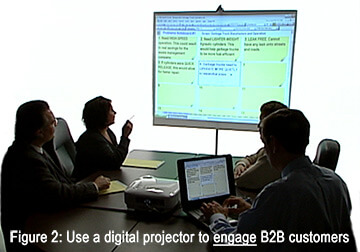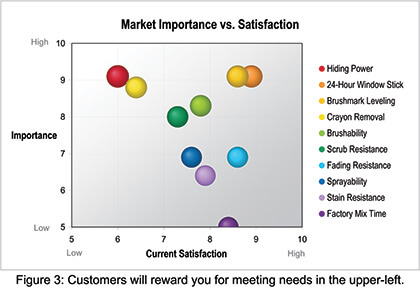Seven Mistakes that Stunt Organic Growth

Sustainable, profitable organic growth. Ahhh, the elixir that prevents business ailments–from down-sizing to grumpy investors. Gaining it sounds so simple: Develop products and services that deliver more value to customers than your competitors’ offerings.
And that’s the snag, isn’t it? Your competitors. For unless your company has smarter employees, some inherent unassailable advantage, or a markedly different approach to satisfying customers… those competitors always seem to limit your growth. But what if you and your competitors were committing seven mistakes that stunt organic growth–and you corrected them? In 20 years these mistakes will be as glaring as trying to improve quality with inspectors rather than statistics. Correct them now for a head start on years of healthy organic growth.
Click here to learn how VoC Tools can boost innovation success
Seven Mistakes That Stunt Organic Growth
#1. Imagining customers’ needs in your conference rooms.
Does your new product process begin with the word “Idea,” perhaps with a light bulb next to it? So whose idea is it: yours or your customers? Most suppliers start with their solution, “validate” it by showing it to some customers, and measure market needs by watching sales results… after product launch!
They should invert this process: Begin with customer needs and end with supplier solutions. Besides, intelligent B2B customers can detect your “validation” a mile away. They correctly sense you are more interested in your idea than in them… and feel like the patient in Figure 1.
#2. Relying on sales reps to capture customer needs.
A salesperson is unlikely to uncover a full set of market needs if he is a) rewarded for near-term selling, b) unable to reach true decision-makers, or c) not calling on most of the customers in your target market segment. Alone, this isn’t a recipe for long term, organic growth success. But put a good salesperson on a team with marketing and technical colleagues, train all in advanced B2B interviewing methods, and you’ll run circles around your competitors. Be wary of VOC (voice-of-the-customer) consultants who want to exclude your sales force from interviews because “they can sell but not listen.” In the long run, your company will fall behind competitors with engaged and enlightened sales people.

#3. Counting on just a few VOC experts.
Some companies rely on a handful of internal VOC experts to interview customers. You’ll do far better training a critical mass of employees–who routinely interact with customers–to gather customer needs. Keep your VOC experts as coaches and trainers, but implement “VOC for the masses.” You’ll overwhelm competitors by turning a trickle of customer feedback into a torrent. B2B organic growth requires your company to have an in-house VOC asset… in the form of your customer-facing folks.
Click here to learn how Voice of Customer Tools can boost innovation success
#4. Using hand-me-down consumer-goods methods.
Traditional VOC methods rely on questionnaires, tape recorders and post-interview analyses. That’s fine for consumer-goods, but your B2B customers are insightful, rational, interested and fewer in number. They’re smart and will make you smarter if you engage them in a peer to-peer dialogue. Use a digital projector, let them lead you to their areas of interest, probe with skill, and you’ll be shocked at how much you’ll learn you never knew.

#5. Gathering only qualitative customer feedback.
I met a frustrated marketing manager who had spent months interviewing customers, only to hear his boss say, “Nah, I don’t think they want that; they want this.” His interviews lacked credibility because interviewers often hear want they want to hear… and then parade some customer quotes for support. Customer data is a key organic growth input.
And you need quantitative data, which measure customer importance and satisfaction on key outcomes. (See Figure 3: If you make resins for paint, you’d probably target “Hiding Power” and “Crayon Removal.”) Skip quantification and your new product will be based on assumptions, bias and wishful thinking.

#6. Listening only to immediate customers
Unlike B2C producers, your product might be part of your customer’s product, your customers’ customer’s product, and so on. It’s a mistake to interview only your direct customers, because they are usually unable or unwilling to disclose downstream customers’ deepest needs. Also, B2C producers assign “one vote” per consumer… while you need to weight the buying power and value chain position of downstream customers.
Click here to get the research report “What Drives B2B Organic Growth”
#7. Ignoring competitors when you design your product
I find most product development processes are far too casual–and late–in assessing competitive offerings. Success in organic growth requires more. Your new product only makes a lot of money if two conditions are satisfied: A) Your product offers significant value to customers, and B) customers cannot get this value elsewhere. Interviews only tell you about Condition A. You need side-by-side testing to learn about Condition B. This allows you to attack competitive weak spots, avoid getting blind-sided, and optimize pricing.
Organic growth seems like a broad subject: Have I focused too narrowly on customer needs? Consider three points: First, the average new product success rate is only one in four. Over 30 years of research says the number one reason is inadequate market understanding.
Second, the “how” continues to get easier than the “what.” You have twin goals of understanding what your customers want, and then how to satisfy them with your solutions. In these days of open innovation and global access to technology, the “how” is easier than it’s ever been… if you have a solid grasp of the “what.”
Finally, you reap benefits beyond good product design when you use respectful peer-to-peer interviews. You engage customers in the design process, which primes them to buy your product later. In fact, our clients often enjoy benefits well before product launch: Their interviews cast them as caring, competent suppliers, so they have a better shot at other near-term business.
Learning More about Organic Growth…
At AIM, we focus exclusively on B2B organic growth, by training commercial and technical personnel in New Product Blueprinting… a process that brings clarity to the “fuzzy front end.” The process eliminates all seven organic growth mistakes. Learn more by reading our book on the subject: New Product Blueprinting: The Handbook for B2B Organic Growth by Dan Adams (available at www.amazon.com). Further, check out this recent research on B2B organic growth.
Comments